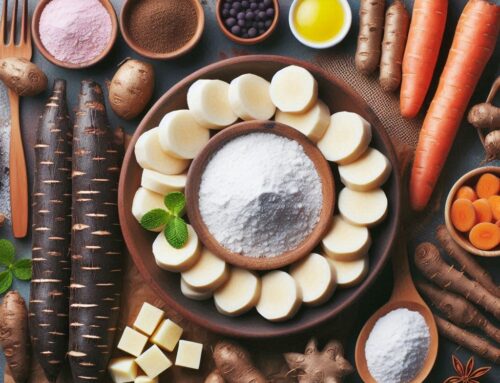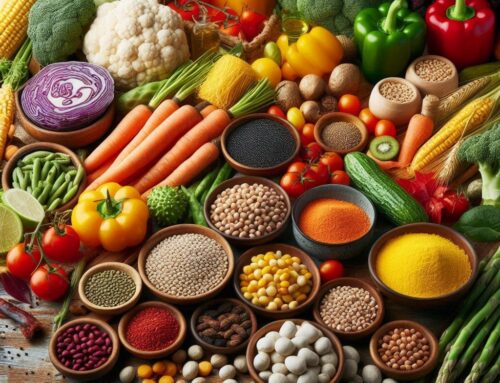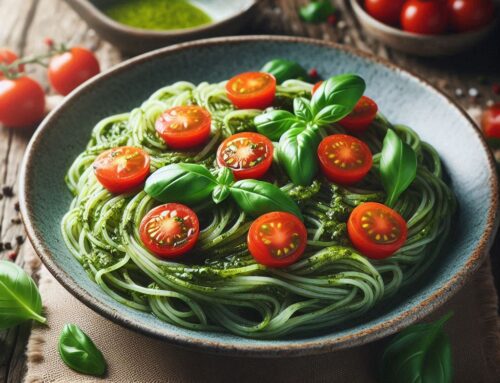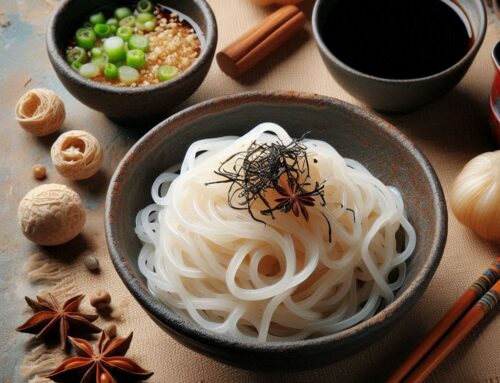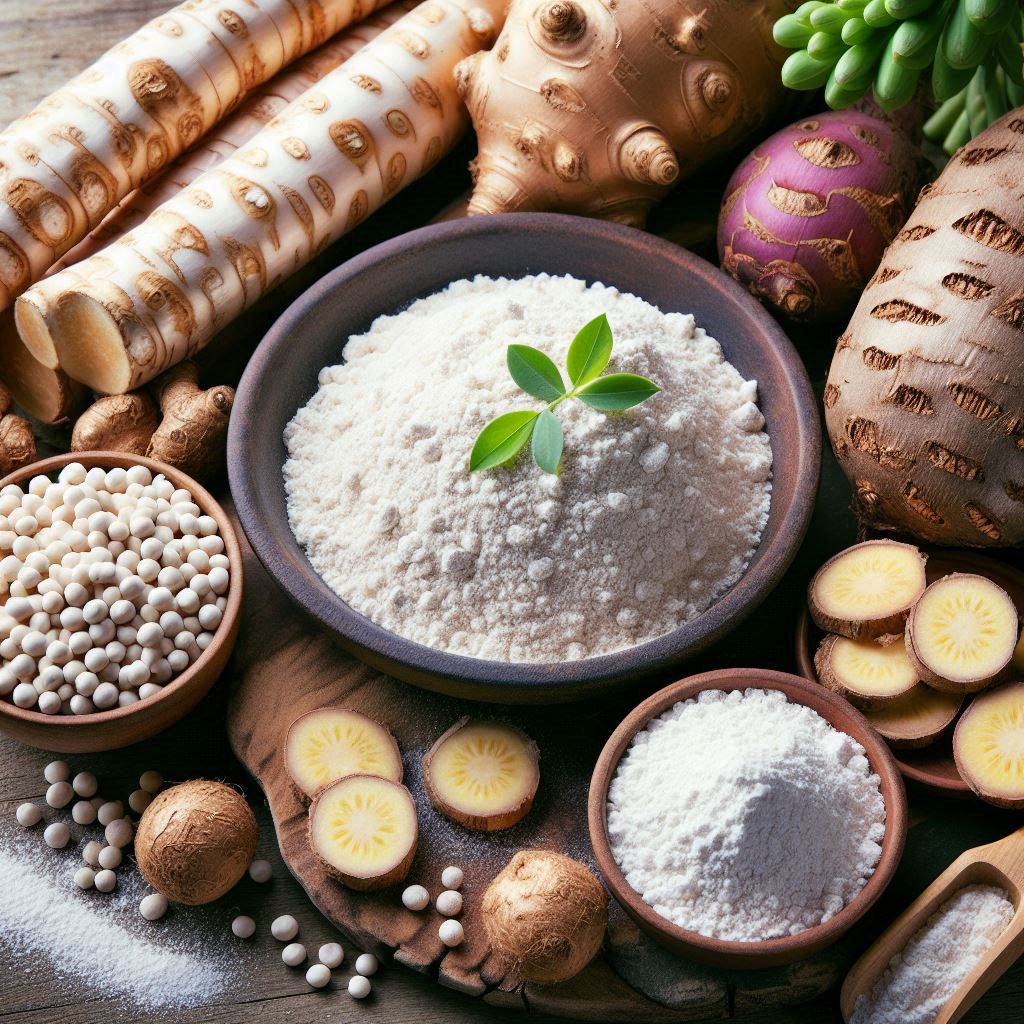
Introduction to Gluten-Free Alternatives: Konjac and Cassava Explained
As awareness of gluten intolerance and celiac disease grows, more people are exploring gluten-free dietary alternatives to maintain a healthy lifestyle. Two popular options gaining traction in the world of gluten-free foods are konjac root and cassava plant. Both offer unique benefits and can serve as excellent substitutes for traditional wheat-based products.
Konjac root, often used to make shirataki noodles, is a staple in Asian cuisine known for its low-calorie content and high fiber levels. This makes it an ideal choice for those looking to manage their weight while adhering to a gluten-free diet. The root’s fiber, glucomannan, not only aids digestion but also helps maintain steady blood sugar levels.
On the other hand, the cassava plant is a versatile ingredient derived from a starchy tuber native to South America. Cassava flour is increasingly being used as a substitute for wheat flour in baking due to its similar texture and mild flavor. It’s rich in carbohydrates and provides essential nutrients such as vitamin C, making it an excellent option for creating delicious gluten-free baked goods.
Both konjac and cassava offer promising alternatives for those seeking variety in their gluten-free diets without compromising on taste or nutrition. As more people embrace these ingredients, they contribute significantly to expanding the range of available gluten-free foods that cater to diverse culinary preferences.
Nutritional Profile: Comparing Konjac and Cassava
When it comes to exploring the nutritional profiles of konjac and cassava, both offer unique benefits that cater to different dietary needs. Konjac, often celebrated for its role in weight management diets, is renowned for being a low-calorie food with high fiber content. The primary component of konjac is glucomannan, a soluble fiber that not only aids digestion but also helps in maintaining satiety, making it an excellent choice for those looking to manage their calorie intake.
On the other hand, cassava is a staple root vegetable in many parts of the world and provides essential nutrients such as vitamin C and manganese. While it is higher in calories compared to konjac due to its carbohydrate content, cassava offers significant energy and has been a crucial dietary component in regions where food security is a concern.
A nutritional comparison reveals that while konjac shines as a low-calorie option ideal for weight loss diets due to its high fiber content and minimal caloric contribution, cassava stands out for its ability to provide sustained energy and essential vitamins. Both foods have their place within diverse dietary frameworks: konjac as part of low-calorie meal plans focusing on gut health through fiber intake, and cassava as an energy-dense food providing vital nutrients necessary for daily functioning. Understanding these nuances can help individuals make informed decisions based on their nutritional goals and lifestyle needs.
Culinary Uses: How to Incorporate Konjac and Cassava into Your Diet
Incorporating konjac and cassava into your diet can be a delightful way to explore gluten-free cooking while adding variety to your meals. These versatile ingredients have unique properties that make them ideal for those seeking healthier alternatives or simply wanting to try something new.
Konjac noodles, often referred to as shirataki noodles, are made from the root of the konjac plant. They are low in calories and carbohydrates, making them an excellent choice for those on a low-carb or ketogenic diet. Cooking with konjac noodles is straightforward; they can be used as a substitute for traditional pasta in dishes like stir-fries, soups, or even cold noodle salads. To prepare them, rinse thoroughly under cold water to remove their natural odor and then boil briefly before adding your favorite sauces or vegetables.
Cassava flour, derived from the root of the cassava plant, is another fantastic gluten-free option. It has a mild flavor and can be used in various recipes ranging from baked goods to savory dishes. When working with cassava flour recipes, it’s essential to remember that it behaves differently than wheat flour due to its high starch content. For best results in baking, consider combining it with other gluten-free flours like almond or coconut flour. Additionally, when using cassava flour as a thickening agent in sauces or gravies, start with small amounts and gradually increase until you reach the desired consistency.
For meal preparation with konjac and cassava, planning ahead is key. Stock up on fresh vegetables and proteins that complement these ingredients well—such as chicken breast for noodle stir-fries or ground turkey for making tortillas using cassava flour—and experiment with different spices and herbs to enhance flavors without relying on gluten-based products.
By incorporating these versatile ingredients into your culinary repertoire, you’ll not only enjoy delicious meals but also benefit from their healthful properties while embracing creative ways of cooking without gluten.
Health Benefits of Including Konjac in Your Diet
Konjac, a plant native to Asia, is gaining attention for its impressive health benefits, particularly when it comes to weight management and digestive health. The root of the konjac plant is rich in a dietary fiber called glucomannan, which has been shown to offer various advantages for those looking to improve their overall well-being.
One of the primary health benefits of konjac root is its ability to aid in weight management. The glucomannan fiber found in konjac acts as a natural appetite suppressant by expanding in the stomach and promoting a feeling of fullness. This can help reduce overall calorie intake, making it easier for individuals to maintain or achieve their desired weight goals. Additionally, this fiber slows down the absorption of carbohydrates and fats, further supporting weight management efforts.
In terms of digestive health improvement, konjac plays a significant role as well. The soluble fiber in konjac helps regulate bowel movements by adding bulk to stools and promoting regularity. This can be particularly beneficial for individuals dealing with constipation or irregular bowel habits. Moreover, konjac’s prebiotic properties support gut health by fostering the growth of beneficial bacteria in the digestive tract.
Incorporating konjac into your diet can be an effective way to harness these health benefits while enjoying versatile culinary options such as noodles or rice substitutes made from this remarkable root. As always, it’s advisable to consult with a healthcare professional before making significant changes to your dietary regimen.
The Advantages of Using Cassava in Gluten-Free Cooking
Cassava has emerged as a star ingredient in the realm of gluten-free cooking, offering a range of health advantages that make it an appealing choice for those seeking naturally gluten-free ingredients. As a root vegetable, cassava is inherently free from gluten, making it an excellent alternative for individuals with celiac disease or gluten sensitivities. One of the primary benefits of incorporating cassava into your diet is its status as an energy-boosting food. Rich in carbohydrates, cassava provides a quick and sustainable source of energy, which can be particularly beneficial for active individuals or those needing an extra boost throughout the day.
Beyond its energy-enhancing properties, cassava is also packed with essential nutrients such as vitamin C, potassium, and dietary fiber. These nutrients support overall health by boosting immune function, maintaining healthy blood pressure levels, and promoting digestive health. The versatility of cassava makes it easy to incorporate into various dishes—from breads and pastries to soups and stews—allowing you to enjoy its benefits without compromising on taste or texture.
In summary, using cassava in gluten-free cooking not only caters to dietary restrictions but also enhances nutritional intake with its array of health advantages. Its role as a naturally gluten-free ingredient combined with its energy-boosting qualities makes it a valuable addition to any kitchen focused on healthy eating.
Potential Drawbacks and Considerations When Consuming Konjac and Cassava
When incorporating konjac and cassava into your diet, it’s important to be aware of certain safety concerns and potential drawbacks. Konjac root, often used in dietary supplements and low-calorie foods due to its high fiber content, can pose some risks if not consumed properly. The primary safety concern with konjac is its ability to expand in the digestive tract, which can lead to blockages or choking hazards if not adequately hydrated or chewed thoroughly. This is particularly important for individuals with swallowing difficulties or those who consume konjac-based products like shirataki noodles.
Cassava, a staple food in many tropical regions, also requires careful preparation due to its natural cyanide content. Raw cassava roots contain cyanogenic glycosides that can release cyanide when consumed. To mitigate this risk, cassava must be peeled and cooked thoroughly before consumption. Improper processing can lead to cyanide poisoning symptoms such as dizziness, headache, and even more severe health issues.
Additionally, both konjac and cassava may cause potential side effects for some individuals. Konjac’s high fiber content might lead to digestive discomforts like bloating or gas for those unaccustomed to a high-fiber diet. Meanwhile, sensitivity to cassava’s residual compounds could trigger allergic reactions in rare cases.
In summary, while both konjac and cassava offer unique nutritional benefits and culinary versatility, it is crucial to consume them responsibly by understanding their preparation requirements and being mindful of any adverse reactions they might provoke.
Sustainability and Environmental Impact of Growing Konjac vs. Cassava
When considering sustainable farming practices, the cultivation of konjac and cassava presents distinct environmental profiles. Konjac, a tuber primarily grown in Southeast Asia, is celebrated for its minimal environmental footprint. Sustainable farming practices for konjac include crop rotation and organic farming methods that help maintain soil health and biodiversity. The plant requires relatively low water input compared to other crops, making it an eco-friendly choice in regions prone to water scarcity.
In contrast, the production of cassava—an essential staple crop in many tropical countries—poses several environmental challenges. Cassava cultivation often leads to soil degradation due to its exhaustive nutrient demands and the common practice of monocropping. Moreover, traditional methods of cassava processing can contribute significantly to water pollution if not managed properly.
Choosing eco-friendly food options involves understanding these impacts. While both crops are valuable for their nutritional benefits and economic importance, konjac stands out as a more sustainable option due to its lower resource requirements and reduced environmental impact. By prioritizing sustainable agricultural practices, such as those used in growing konjac, consumers can make more informed decisions that support ecological balance and long-term agricultural viability.


